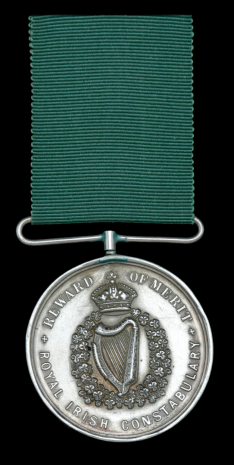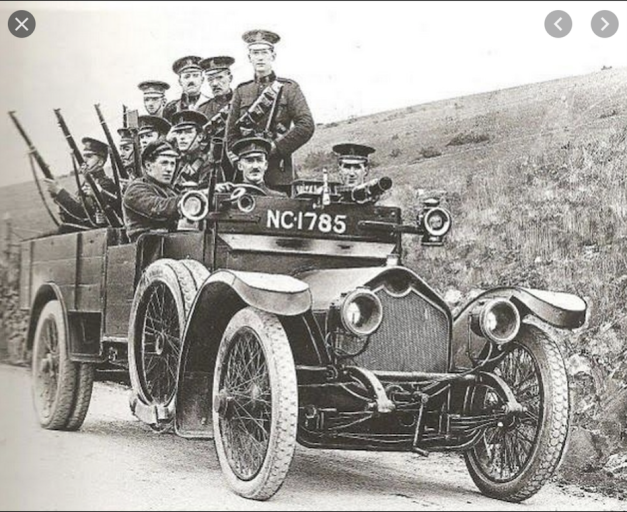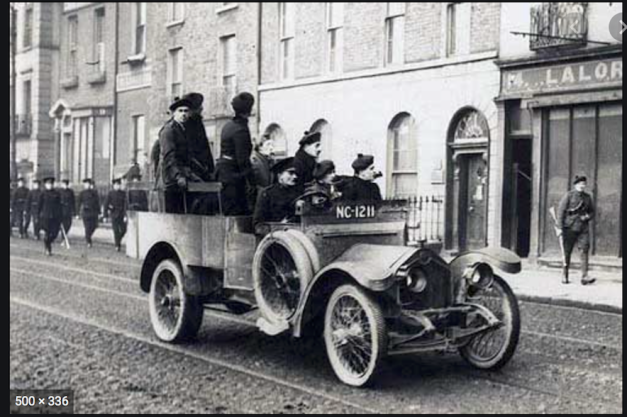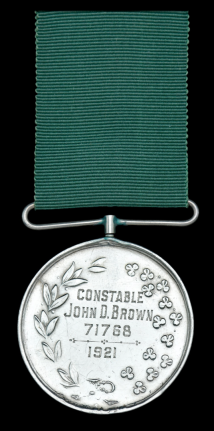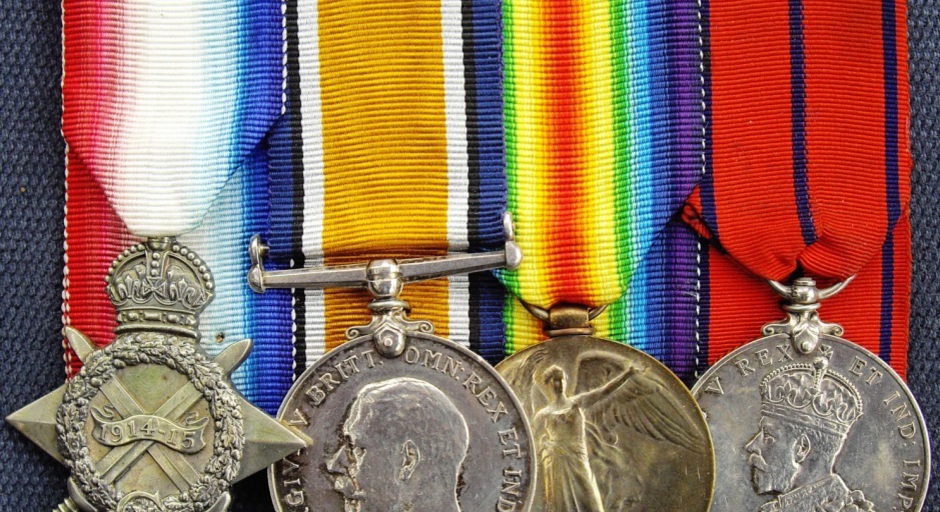
Royal Irish Constabulary - Reserve Constable 71768 John (Jock) Donald Brown a 'Black and Tan'
Royal Irish Constabulary
Temporary Constable 71768 John Donald Brown
Constabulary Medal (Ireland, 1921)
1914 – 15 Star
British War Medal
Victory Medal
Introduction
John Donald Brown was born in Drumforth House in the Parish of Ecclesmachan in the County of Linlithgow on 7 November 1893. His father was William Brown, a Labourer and his mother, Mary Fleming or Brown. His parents were married in Linlithgow on 15 March 1889.
John was a Motor Driver when he enlisted in the Scots Guards as Private 11714 on 20 October 1914 at Lochgelly in Fife.
He served with the 1st, 3rd and 2nd Battalions in France and Belgium, being wounded twice, first by a gas shell in 1917 and then by gunshot wound (GSW) in 1918 recovering from both and being declared ‘fit for further service’.
He was demobbed in Edinburgh in 1920.
With mass unemployment among the troops returning from active service, there were few opportunities for men like John Brown. One such opportunity was created by the political situation in Ireland.
Republican agitation for an independent Irish State had rumbled on for over 200 years but after the Easter Rising of 1916, violent events accelerated. Many experienced junior ranks, Head Constables and Sergeants as well as Constables, took their pensions and there was a manpower crisis. British Government policy was to recruit ‘Temporary Constables’ and ‘Auxiliaries’ from the large pool of unemployed Army officers and other ranks.
RIC Recruiting offices were opened in Glasgow, Liverpool, Manchester, Newcastle-upon-Tyne, Taunton, Bristol, Horsham, Norwich, Kingston-upon-Thames, London and many other English towns and cities. John D Brown enlisted in the Royal Irish Constabulary (RIC) as Temporary Constable No. 71768 on 30 June 1920 during what became known as the ‘War of Independence’ or the ‘Black and Tan War’.
John, (by then known as Jock), Brown was often employed as a Driver and stationed in Thurles, County Tipperary. He was involved in an attempted ambush of a RIC vehicle driven by him and carrying supplies and men near Shevry, on 9 November 1920. For his actions that day, he was awarded a Constabulary Medal (Ireland).
With the partition of Ireland and the declaration of the Irish Free State in 1922, along with the rest of the remaining RIC, he was ‘Disbanded’ and pensioned at Gormanston Camp, Co. Meath on 16 March 1922.
What follows is a history of John Donald Brown’s life as extracted from a range of public documents including ‘family trees’ on Ancestry.co.uk. The information includes his parents, grandparents, brothers and sisters and has been transcribed as it is shown in documents which may have some discrepancies. I have not brought the family details completely up to date to allow for the fact that many are still alive.
The Early Years
The Census of Scotland 1881
The Census of Scotland 1881 records the following living at 64 Charles Street, Camlachie, Glasgow.
|
Name & Age |
Occupation |
Place & County of Birth |
|
Mary Brown, (55) |
Washerwoman (Domestic Servant) |
Inveraray, Argyllshire |
|
Alexander Brown, (23) |
Barber (Apprentice) |
Glasgow, Lanarkshire |
|
William Brown, (18) |
Engineer’s Works Labourer |
Glasgow, Lanarkshire |
This is John Brown’s paternal grandmother, uncle and father well before his marriage to Mary Fleming in 1889. William’s father was Henry (Harry) Brown and his mother’s maiden surname was Gibson. It is possible that Alexander emigrated to North America.
The Census of Scotland 1881
The Census of Scotland 1881 records the following living at Liberton in Midlothian.
|
Name & Age |
Occupation |
Place & County of Birth |
|
John Fleming, (50), |
Farm Servant |
Glenluce, Wigtownshire |
|
Elizabeth Fleming, (50) |
Wife |
Glenluce, Wigtownshire |
|
Mary Fleming, (12) |
Scholar |
Cramond, Midlothian |
|
John Fleming, (8) |
Scholar |
Gilmerton, Midlothian |
|
Grace Fleming, (5) |
Scholar |
Gilmerton, Midlothian |
This is John Brown’s maternal grandparents, uncles, aunts and mother well before her marriage to William Brown in 1889.
The Census of Scotland 1891
The Census of Scotland 1891 records the following living at Drumforth House, Ecclesmachan, West Lothian. Drumforth is to the north of Ecclesmachan village.
|
Name & Age |
Occupation |
Place & County of Birth |
|
William Brown, (28) |
Platelayer |
Glasgow, Lanarkshire |
|
Mary Brown, (23) |
Wife |
Cramond, Edinburghshire |
|
Henry Brown, (1) |
|
Ecclesmachan, West Lothian |
|
John Fleming, (60) |
Farm Labourer |
Glenluce, Wigtownshire |
I believe John Fleming is Mary’s father.
Register of Births in the Parish of Ecclesmachan in the County of Linlithgow 1893
John Donald Brown was born on 7 November 1893 at Drumforth in the Parish of Ecclesmachan in the County of Linlithgow on 7 November 1893. His father was William Brown, a Labourer and his mother, Mary Fleming or Brown. His parents were married in Linlithgow on 15 March 1889.
The Census of Scotland 1901
The Census of Scotland 1901 records the following living at Mounthooley, Ecclesmachan, West Lothian on the night of the Census.
|
Name & Age |
Occupation |
Place & County of Birth |
|
William Brown, (38) |
Shale Mine, Foreman Labourer |
Glasgow, Lanarkshire |
|
Mary Brown, (32) |
Wife |
Cramond, West Lothian |
|
Henry Brown, (12) |
Scholar |
Ecclesmachan, West Lothian |
|
Elizabeth Brown, (9) |
Scholar |
Ecclesmachan, West Lothian |
|
John Brown, (7) |
Scholar |
Ecclesmachan, West Lothian |
|
Mary Brown, (5) |
Scholar |
Ecclesmachan, West Lothian |
|
William Brown, (3) |
|
Ecclesmachan, West Lothian |
|
Thomas Brown, (1) |
|
Ecclesmachan, West Lothian |
Although the document states that Mounthooley is near Ecclesmachan, it is actually in the district of Dalmeny north of the Edinburgh Road (modern A9), north east of Three Miletown.
The Census of Scotland 1911
The Census of Scotland 1911 records the following living at 7 The Avenue, Philpstoun, West Lothian on the night of the Census. Philpstoun is to the north west of Mounthooley.
|
Name & Age |
Occupation |
Place & County of Birth |
|
William Brown, (47) |
Foreman Labourer, Oil Manufacturer |
Glasgow, Lanarkshire |
|
Mary Brown, (42) |
Wife |
Cramond, Midlothian |
|
Harry Brown, (21) |
Pitheadman |
Ecclesmachan, West Lothian |
|
John Brown, (17) |
Pony Driver |
Ecclesmachan, West Lothian |
|
Mary Brown, (15) |
At Home |
Ecclesmachan, West Lothian |
|
William Brown, (13) |
School |
Ecclesmachan, West Lothian |
|
Thomas Brown, (11) |
School |
Ecclesmachan, West Lothian |
|
Helen Brown, (9) |
School |
Ecclesmachan, West Lothian |
|
Grace Brown, (9) |
School |
Ecclesmachan, West Lothian |
|
Isabella Brown, (7) |
School |
Ecclesmachan, West Lothian |
I have been unable to find Elizabeth Brown in 1911 due to the high number of women throughout Scotland with that name.
The 1911 Census was the first to demand information from married women stating how long they had been married, how many live births they had experienced and how many of their children were still alive. Mary stated she had been married 22 years, had nine live births and all nine were still alive on the date of the Census.
The table below shows the full names of each of William and Mary Brown’s family:
|
Henry Brown, born 6 March 1890, Linlithgow, West Lothian |
|
Elizabeth Parker Brown, born 1 September 1891, Ecclesmachan, West Lothian |
|
John Donald Brown, born 7 November 1893, Ecclesmachan, West Lothian |
|
Mary Fleming Gibson Brown, born 26 January 1896, Ecclesmachan |
|
William Brown, born 16 November 1897, Ecclesmachan, West Lothian |
|
Thomas Arthur Brown, born 28 March 1900, Ecclesmachan, West Lothian |
|
Helen Fleming Brown, born 17 March 1902, Ecclesmachan, West Lothian |
|
Grace Fleming Brown, born 17 March 1902, Ecclesmachan, West Lothian |
|
Isabella Brown, born 28 September 1903, Mounthooley, Ecclesmachan, West Lothian |
Register of Corrected Entries in the District of Linlithgow, in the County of Linlithgow 1918
This register shows that on 9 November 1918, a Decree of Divorce was granted by the Lords Ordinary in an action at the instance of Mrs Mary Fleming or Brown, 34 Buccleuch Place, Edinburgh against William Brown, Oil Works Foreman, care of McCormack, 153 Waddell Street, Glasgow.
The Scots Guards 1914 - 1920
John Donald Brown, aged 20 years and 11 months, enlisted in the Scots Guards at Lochgelly in Fife on 20 October 1914. He was given the Army No. 11714 and enlisted for ‘three years with the Colours, or the Duration of the War’. He was posted to the Guards Depot at Caterham in Surrey on 23 October. He was posted to the 1stBattalion on enlistment.
He was described as 5’8” tall, 138 lbs in weight, with a fresh complexion, grey eyes and dark brown hair. His religion was ‘Presbyterian’.
Lieutenant Alexander Stephen, RAMC, the Medical Officer at Lochgelly ‘considered him fit for the Army’.
His next of kin was listed as ‘William Brown, (Father), The Avenue, Philpstoun, Linlithgowshire’.
John’s postings were as shown in the table below.
|
Country |
From |
To |
Years |
Days |
|
Home |
20 October 1914 |
14 April 1915 |
|
177 |
|
British Expeditionary Force, France |
15 April 1915 |
2 November 1917 |
2 |
202 |
|
Home |
3 November 1917 |
29 March 1918 |
|
147 |
|
British Expeditionary Force, France |
30 March 1918 |
12 February 1919 |
|
320 |
|
Home |
13 February 1919 |
12 March 1919 |
|
28 |
|
|
Total |
4 |
145 |
|
During his time in France and Belgium, his Army record notes that he was wounded in action on two occasions:
|
Event |
Date |
Reference |
Injury |
|
Wounded in Action |
14 October 1917 |
A.F.B. 103 |
Gas |
|
Wounded in Action |
3 September 1918 |
A.F.B. 103 |
G.S.W. Face |
On 3 November 1917, John was admitted to the 3rdScottish General Hospital, then located at Stobhill in Glasgow and under Royal Army Medical Corps Territorials. Wounded troops were brought from the continent by train, arrived at a temporary platform on a railway siding which ran into the hospital grounds. The hospital had 70 Officer beds and 1629 for ‘Other Ranks’.
On 28 November 1917, John was admitted to the 1stScottish General Hospital in Aberdeen. Aberdeen was also a Territorial Force hospital with 62 beds for Officers and 1297 for ‘Other Ranks’.
Campaigns, Medals and Decorations
The same page of his Army Record also records under ‘Campaigns, Medals and Decorations’, his entitlement to:
The 1914 – 15 Star
The British War Medal (BWM) and,
The Victory Medal (VM).
11714 John Donald Brown’s Certificate of Discharge was issued at No.1 Dispersal Unit at Duddingston Camp in Edinburgh on 13 February 1919. His future intended address was given as 34 Buccleuch Place Edinburgh, his mother’s address.
He was officially discharged on 13 March 1919.
Register of Marriages in the District of St Giles in the City of Edinburgh 1920
On 7 February 1920, John Donald Brown, (26), Ship Stager, married Catherine Mary Alice Dickson, (24), Clerk, in the District of St Giles in Edinburgh. The witnesses were Thomas Arthur Brown, Ship Stager, and Mary Fleming Gibson Brown, Serving Maid.
It seems that John Brown worked in a shipyard in Leith after discharge but the political situation in Ireland after 1916 and the Government in London’s policies for dealing with it created the conditions whereby a massive recruitment drive was necessary for the RIC in 1920 – 1922. In June 1920, he successfully applied for appointment as a Temporary Constable in the RIC.
Scots Guards Records 1921
Documentation in his Army Record shows that the BWM and VM were received by John Brown and he signed and dated the receipt on 28 March 1921.
The Royal Irish Constabulary Temporary Constables 1920 -1922
The Irish Republican Brotherhood, the Irish Volunteers, the Irish Republican Army and many others were fighting in a struggle for Irish Independence from the United Kingdom of Great Britain and Ireland. Attacks on the RIC had continued for many years but intensified after the Easter Rising in Dublin in 1916. As a result, many long-serving and experienced RIC men retired on pension.
The republicans had instituted a ‘Boycott’ of the RIC men regarding them as ‘Traitors to Ireland’. The Boycott applied equally to their wives and families and that meant anyone having dealings with any of them, even selling provisions to them, would be punished in reprisals by the local Volunteers. There were numerous examples of RIC men being shot going or coming from Mass or Police Barracks being set alight and destroyed, especially in rural Ireland.
In 1920, 25 RIC Head Constables and 190 Sergeants retired on pension. In addition, 149 Constables also took the same opportunity. In 1916, the officers of the RIC, Cadets, District Inspectors and above, were 95% Protestant. The junior ranks, Head Constables, Sergeants and Constables, were 95% Roman Catholic, like most of the population they policed.
Every man who was pensioned had completed at least 25 – 30 years’ service if not more and the loss of experience at the most senior non-officer rank must have had a detrimental effect on the supervision and discipline of the inexperienced officers then being employed as ‘Temporary Constables’.
It may be instructive to mention the number of RIC men killed by acts of political violence between 1916 and disbandment of the force in 1922. 457 RIC men died by acts of political violence, 92 died by other means, a total of 549.
In 1920, the figures began slowly but grew to a peak of 46 in November and averaged out at 17 deaths per month for that year, a total of 204.
British Government policy was that the RIC could and would deal with the republican threat, supported by the British Army. It was an impossible task. The British solution was to recruit ‘Temporary Constables’ and ‘RIC Auxiliaries’ from the ranks of former officers and ‘other ranks’ of the newly battle-hardened but demobbed British Army.
‘Black and Tans’ was the nickname given to the Temporary Constables recruited in Britain for service between 1920 - 1922. The name came from the fact that there was a shortage of the rifle green uniform of the RIC. This was overcome by issuing recruits with a mixture of Army khaki and RIC rifle green clothing so that some might be wearing rifle green tunics with khaki trousers and vice versa. All wore the RIC green caps. The Temporary Constables patrolled and billeted with the regular RIC in Barracks throughout Ireland. The ‘Auxies’ tended to be billeted separately.
It is widely, if erroneously, believed that the ‘Black and Tans’ were recruited from British Prisons. The reality is that they were not. The ‘Auxiliaries’ were almost exclusively from the ranks of ex-officers in the British forces. That said, many ex-officers had been commissioned from the ranks as the war had gone on. The Temporary Constables were recruited from the ‘other ranks’ of the military. Far from being recruited from the ‘dregs of society’, each mans’ military record was checked, and a character reference obtained from their former regiment. The correspondence in John Donald Brown’s case still exists in his Army Record and his conduct was described as ‘Very Good’.
The ‘Black and Tans’ are often confused and conflated with the force of mainly, but not exclusively, ex-Army officers known as Auxiliaries or ‘Auxies’. The ‘Auxies’ usually wore khaki uniforms and a Scottish style ‘Tam o’ Shanter bonnet with their respective column badge. They were classed as ‘Temporary Cadets’ with the rank of Sergeant and tended to operate as ‘Mobile Columns’ in Company strength as a paramilitary assault force in areas of higher resistance to British Rule, mainly the south and west of Ireland.
It is accurate to state that both units, ‘Tans’ and ‘Auxies’, were suspected, and guilty of, many violent acts of intimidation, retribution and revenge in the short time they were in Ireland engaged in a violent conflict in which both sides could be equally accused.
Temporary Constable 71768 John Donald Brown
John Donald Brown enlisted in the RIC at the Recruiting Office in Glasgow on 30 June 1920. He was appointed a Temporary Constable on 28 July 1920.
It was the custom in the RIC to note the county of birth of recruits and also those of the residence of close family so that he would never be posted to an area of potential conflicts of loyalty. John stated his place of birth as Linlithgow and that he had family resident in Fife, West Lothian and Midlothian.
Unusually, his service in the Scots Guards is not noted on his RIC personnel file although they clearly sought a reference from the regiment which still exists in his personnel file.
After basic training, he was posted to the town of Thurles in the North Riding of County Tipperary in South East Ireland.
As a Temporary Constable, he would have been stationed at a Barracks along with regular RIC officers and expected to behave to the same standards and norms as his colleagues. He would have carried out patrols on foot, bicycle and by motor vehicle, usually, a Crossley Tender, an Army troop carrier. He would have been armed with a service revolver and usually a rifle and bayonet.
The Ambush at Shevry, Co. Tipperary 1920
Constable Brown was on duty at 4.30pm on 9 November 1920 driving a RIC Crossley Tender westwards on the road between Thurles and Shevry with about ten other constables and supplies when it was ambushed by a force of Irish Volunteers led by James Leahy. The official recommendation for the Constabulary Medal states:
“At 4:30 p.m. on 9 November 1920, a Crossley car driven by Constable Brown was ambushed near Shevry, co. Tipperary, by about 100 armed men who blocked the road by two carts tied together. Bombs were hurled at the car and police, and about 60 or 70 rifle and revolver gun shots were fired at them. The police promptly returned the fire and Constable Brown putting on speed rushed the carts, took one of them on the bonnet of the motor, and got safely through. The Constable by his nerve and cool driving undoubtedly saved the whole party.”
For his actions in neutralising the Shevry ambush by his defensive driving skills, Constable Brown was awarded the Constabulary Medal on 22 February 1921, a First-Class Favourable Record and a grant of £5.
The Irish Bureau of Military Affairs
After the partition of Ireland in 1922, the bitter Civil War followed and deep divisions which exist to this day caused much more suffering and death. In the 1950’s, the Irish Government carried out an exercise to document the history of the War of Independence. Former republican soldiers gave written testimony of their involvement and many took the opportunity to have their versions of the events recorded. One such record is that of James Leahy, the former Brigade Commandant of the No. 2 (Mid) Tipperary Brigade of the Irish Volunteers which runs to 80 plus foolscap pages. The statement describes the activities of the Irish Volunteers, Irish Republican Brotherhood and Sinn Fein in and around Thurles Co. Tipperary between 1914 and July 1921.
Page 55 of Leahy’s statement, written in 1956, 36 years after the event, contains the following assessment of the ambush at Shevry on 9 November 1920.
“Towards the end of October 1920, an attack, for which elaborate preparations had been made by the 3rd Battalion, was cancelled by me at the last moment. This was to be an attempt to capture and destroy Shevry Barracks which was held by about 15 policemen.
Details of the layout of the barracks had been supplied to Jim Stapleton by a local postman, Paddy Boyle, who pretended friendship with the police while, in reality, he was an intelligence officer of ours… Eight or ten days afterwards, we prepared for another operation in the same locality which also turned out to be abortive.
A single lorry was still bringing rations and other supplies from Thurles to the Shevry police. About 9 November 1920, an ambush was prepared at Ballyboy, outside Upperchurch, to attack this lorry which normally was carrying a mixed force of police and soldiers numbering between ten and twelve. A horse cart was placed across the road to act as a barricade and the attacking party, about 15, were mostly belonging to the Upperchurch company. I was in charge myself.
At about 4 o’clock in the evening, just as the lorry was approaching the barricade, one of my men accidentally discharged a shot. This alerted the driver, a highly competent one, too, who was known to us as “Jock”. On hearing the shot, he accelerated the vehicle which crashed its way through the cart and then drove off at top speed. Though we fired several shots the enemy had no casualties.”
The wide variance between Leahy’s assessment of numbers of Irish Volunteers involved in the attack and that on the official citation, (100 versus 15), can be explained on the tendency for the republican statements completed 30 years after the events to emphasise their successes whilst minimising their failures.
Royal Irish Constabulary ‘Favourable Records’
Brown gained 3rd Class Favourable Records on three subsequent occasions in 1921. They were on 15 March 1921, and for two incidents on 20 August 1921. He seems to have been efficient in his duties as a temporary Constable as many left after short periods complaining about the ‘discipline, ‘food and accommodation’ and ‘poor prospects’ and some were discharged for ‘disobedience to orders’.
Royal Irish Constabulary List, 1921
On page 72 of the RIC List for 1921, the names of Head and other Constables holding medals is listed. Among the names is ‘71768 Brown, John, D., Constable, Constabulary Medal’.
Royal Irish Constabulary Disbandment
He was ‘Disbanded’ from the RIC at Gormanston Camp, Co Meath on 16 March 1922. Constable Brown had completed 1 year and 8 months service giving him the equivalent of 14 years’ ‘Pensionable Service’. This entitled him to an annual pension of £54. 12/- (£54.60).
Register of Corrected Entries in the District of St Giles, in the City of Edinburgh 1926
An entry dated 20 February 1926 in the Register of Corrected Entries in the District of St Giles in the City of Edinburgh notes that a Decree of Divorce was granted by Lord Fleming at the instance of Catherine Alice Mary Dickson or Brown of 130 Buccleuch Street, Edinburgh, against John Donald Brown, Ship Stager, 34 Buccleuch Place, Edinburgh.
Register of Marriages in the District of Blythswood in the City of Glasgow 1926
On 7 April 1926, in the District. Of Blythswood in Glasgow, John Donald Brown married Henrietta Pattison McKay Scott. One of the witnesses to the marriage was Ella (Isabella) Brown. I believe that the couple had a child together and she may still be alive.
Register of Deaths in the City of Edinburgh 1943
Mary Fleming or Brown died in Edinburgh on 31 March 1943.
Register of Deaths in the District of Leith in the City of Edinburgh 1965
John Donald Brown, (71), an Engineer’s Clerk (Retired), of 400 Ferry Road, Leith, died in the Leith Hospital on 28 June 1965. He was the son of William Brown, a Shale Works Under Manager and Mary Fleming or Brown, both deceased. His brother, William Brown of 24 Brougham Place, Edinburgh, registered his death. His cremation took place in Edinburgh o 30 June 1965.
The End of the Story
If you are able to add anything to this interesting story of a ‘Black and Tan’ or indeed, have a picture of him in uniform, please get in touch via enquiries@scottishpolicemedals.co.ukThank you.
